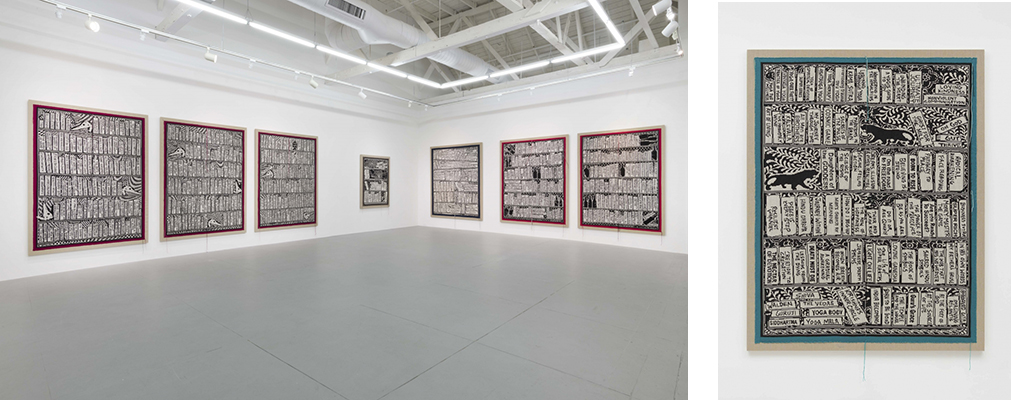March 7, 2019
Lisa Anne Auerbach
Libraries
Gavlak Los Angeles
February 7 - March 16, 2019

Installation view
When looking at books on a shelf, it is difficult not to see the titles in relation to each other and to think about the ways they connect and how they might relate to the person who collected them. Lisa Anne Auerbach's installation Libraries is comprised of images of bookshelves compiled by visiting or researching books in public archives, as well as documenting those from select personal collections. In libraries, one finds books of all shapes, colors and sizes with titles presented in myriad styles. Auerbach equalizes these books by stripping of them not only of their authors, but also of their original color and fonts, transforming them into black and white knitted tapestries of titles, rearranged to maximize poetic and aesthetic resonance.
To fully engage with these pieces, it is necessary to both look and read. In Fear (2018), a work based on an imagined Donald Trump bookshelf, the titles include Mein Kampf, The Way to Success, The Best Golf Advice I Ever Received, Crippled America and Think Like a Billionaire. These titles share the shelves with images of guns and spiderwebs. In Water and the California Dream, (2019), interspersed between plants are titles such as: Food Wars, Big Chicken, Utopianism, Fast Food Nation and Radical Agriculture. Radical Awakening, (2018), places books like Grist for the Mill, On God, Walden, Yoga Body, etc. between floral patterns and statues of prancing beasts.
Auerbach's works, fabricated on knitting machines with the aid of a computer, call attention to the tensions, contradictions and similarities between analog and digital forms of communication and creation. In an age when more and more books are being digitized or even Tweeted in short bursts, the printed book and it's presence on a shelf has an archaic resonance that harkens back to ancient libraries as the source of knowledge and information rather than Wikipedia and Google.
These knitted libraries illustrate not only diverse tastes in reading, but when seen en masse they have the feel of concrete poetry. The relationship of the titles within each red, green, blue or black outlined panel become a quasi-portrait especially when augmented by the other items Auerbach includes on the shelves. Yet portraits of whom, is never revealed. Together, these large-scale knitted paintings present just a fraction of the books in print and speak to the wealth of subjects available to explore. That aside, the fun in these works is reading the tiles across and down as fragmented narratives and found poetry.
Libraries
Gavlak Los Angeles
February 7 - March 16, 2019

Installation view
When looking at books on a shelf, it is difficult not to see the titles in relation to each other and to think about the ways they connect and how they might relate to the person who collected them. Lisa Anne Auerbach's installation Libraries is comprised of images of bookshelves compiled by visiting or researching books in public archives, as well as documenting those from select personal collections. In libraries, one finds books of all shapes, colors and sizes with titles presented in myriad styles. Auerbach equalizes these books by stripping of them not only of their authors, but also of their original color and fonts, transforming them into black and white knitted tapestries of titles, rearranged to maximize poetic and aesthetic resonance.
To fully engage with these pieces, it is necessary to both look and read. In Fear (2018), a work based on an imagined Donald Trump bookshelf, the titles include Mein Kampf, The Way to Success, The Best Golf Advice I Ever Received, Crippled America and Think Like a Billionaire. These titles share the shelves with images of guns and spiderwebs. In Water and the California Dream, (2019), interspersed between plants are titles such as: Food Wars, Big Chicken, Utopianism, Fast Food Nation and Radical Agriculture. Radical Awakening, (2018), places books like Grist for the Mill, On God, Walden, Yoga Body, etc. between floral patterns and statues of prancing beasts.
Auerbach's works, fabricated on knitting machines with the aid of a computer, call attention to the tensions, contradictions and similarities between analog and digital forms of communication and creation. In an age when more and more books are being digitized or even Tweeted in short bursts, the printed book and it's presence on a shelf has an archaic resonance that harkens back to ancient libraries as the source of knowledge and information rather than Wikipedia and Google.
These knitted libraries illustrate not only diverse tastes in reading, but when seen en masse they have the feel of concrete poetry. The relationship of the titles within each red, green, blue or black outlined panel become a quasi-portrait especially when augmented by the other items Auerbach includes on the shelves. Yet portraits of whom, is never revealed. Together, these large-scale knitted paintings present just a fraction of the books in print and speak to the wealth of subjects available to explore. That aside, the fun in these works is reading the tiles across and down as fragmented narratives and found poetry.